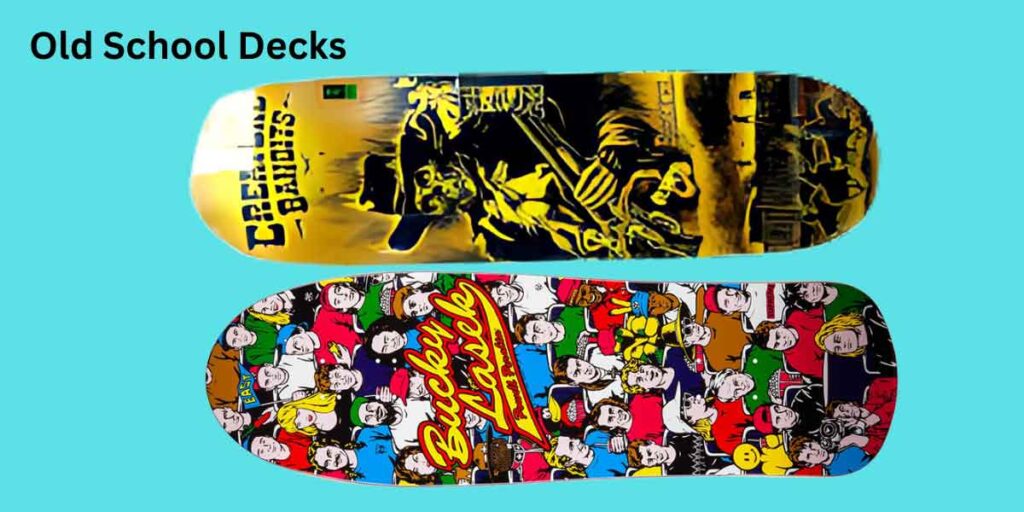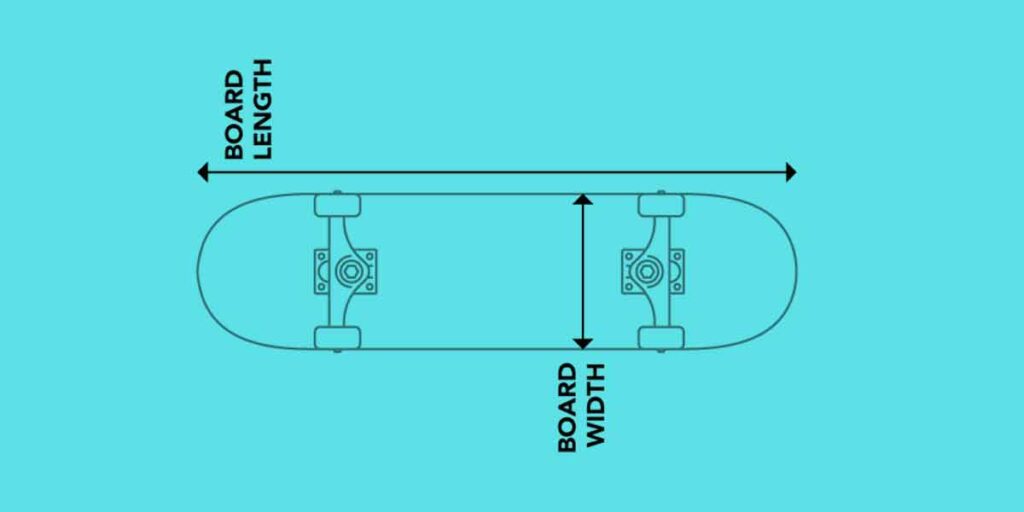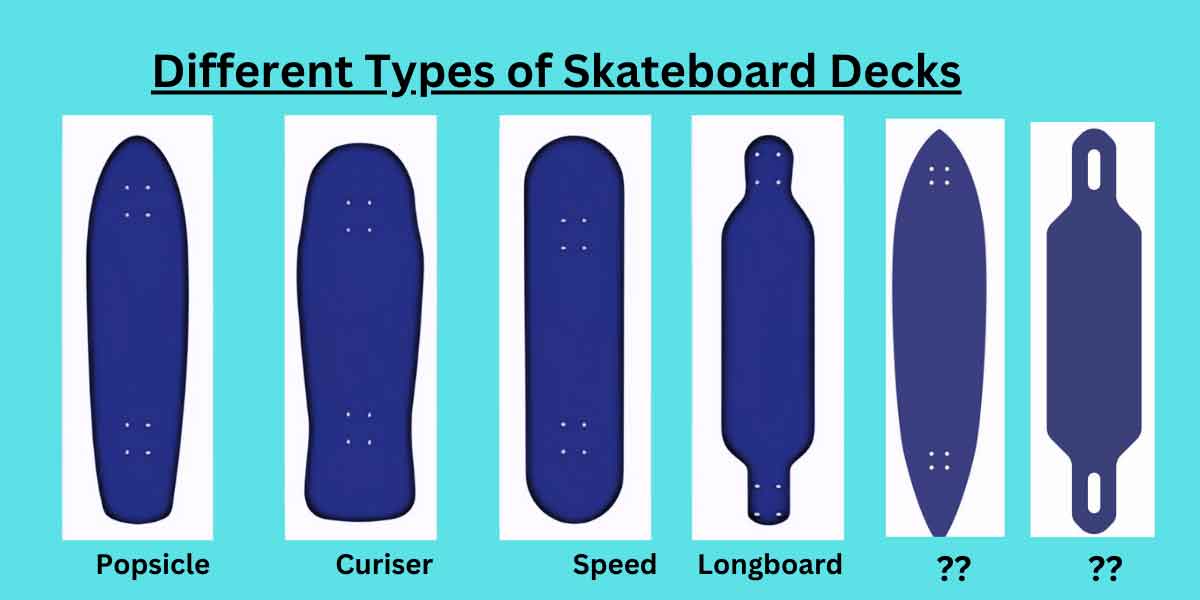There are several types of skateboard decks: street decks, cruiser decks, mini decks and longboard decks. Each type serves different skateboarding styles.
Skateboard decks come in various shapes and sizes, tailored to specific skateboarding needs. Street decks are ideal for tricks and technical skating due to their lightweight and compact design. Cruiser decks provide a smooth ride, perfect for commuting and casual riding.
Longboard decks offer stability and comfort. These features make them suitable for downhill racing and long-distance cruising. Choosing the right deck depends on your skating style and preferences. Understanding these types helps you select the best skateboard for your activities. Whether you enjoy performing tricks, cruising around town, or racing downhill, there’s a skateboard deck for your better experience.
Breakdown of Skateboard Deck Types
1. Standard/Street Decks
The most common type of skateboard deck typically measures between 7.5” to 8.5” in width. Street decks, also known as popsicle decks, are designed for technical tricks, street skating, and park skating. They feature a symmetrical shape with a slight concave, which provides the pop necessary for flips and other tricks.

Key Features
- Lightweight design for easy maneuverability.
- Double kicktails (raised ends) for performing tricks.
- Suitable for street, park, and technical skating.
Best For: Skaters who focus on flips, grinds, and technical tricks.
Pros & Cons
Pros: Versatile, widely available, and excellent for skateboarding tricks.
Cons: Less stable at high speeds and on rough surfaces, making them less ideal for cruising or downhill riding.
2. Cruiser Decks
Cruiser decks are wider and often shorter than standard decks. These are made primarily for comfortable rides and smooth cruising. They come in various shapes and often feature softer, larger wheels that glide effortlessly over rough terrain.
Key Features
- A comfortable ride with soft wheels for better shock absorption.
- Kicktail for easy maneuverability, especially in tight spaces.
- A variety of shapes and sizes, from mini-cruisers to full-sized decks.
Best For: Skaters looking for a board that’s easy to ride around town, commute with, or enjoy casual rides on.
Pros & Cons
Pros: Smooth ride, easy to control, great for commuting.
Cons: Not suitable for performing technical tricks or high-speed downhill skating.
3. Longboard Decks
Longboards are significantly longer and wider than standard decks. These are for speed, stability, and smooth cruising. They come in various shapes, such as pintails, drop-throughs, drop decks and so on.
Key Features
- Decks typically over 36” in length for added stability.
- Various shapes are designed for specific riding styles, such as carving, downhill racing, or cruising.
- Often feature large, soft wheels for smooth, fast rides.
Best For: Riders focused on downhill racing, carving, and long-distance cruising.
Pros & Cons
Pros: Extremely stable at high speeds, perfect for long-distance rides, and smooth over rough surfaces.
Cons: Difficult to perform tricks, less portable due to size, and heavier than other decks.

4. Old School Decks
Description: Old-school decks are reminiscent of the 1980s skateboard designs. These boards feature a wider, asymmetrical shape with a flat nose and a kicktail. They are ideal for pool skating, vert, and ramp riding.
Key Features
- Wide, flat shape with a single kicktail.
- Larger surface area, providing stability and control on ramps and pools.
- Often designed with bold, retro graphics.
Best For: Skaters into vert, pools, and ramps, or those who prefer a retro aesthetic.
Pros & Cons
Pros: Excellent stability, great for vertical tricks, and comfortable for older skaters used to the classic style.
Cons: Heavier and less maneuverable than modern street decks, not ideal for street tricks.
5. Mini Decks
Description: Mini decks are smaller versions of standard decks.. They are designed specifically for young skaters or those with smaller feet. They offer the same features as standard decks but are scaled down in size to provide better control for kids.
Key Features
- Shorter in length and narrower in width, making them lighter and easier to control.
- Designed for beginners, especially children learning to skate.
- Often come in fun, colorful designs appealing to younger skaters.
Best For: Kids and young beginners who need a board that matches their size.
Pros & Cons
Pros: Perfect for small feet, lightweight, easy to control, and great for learning basic tricks.
Cons: Limited in performance as the skater grows, requiring an upgrade to a full-sized deck eventually.
6. Shaped Decks
Shaped decks are unique, non-standard decks. These boards come in various shapes, designed for specific styles of skating or personal aesthetics. They combine elements of old-school and modern deck designs to cater to niche preferences.
Key Features
- Varied shapes like fish tails, square tails, or completely custom designs.
- Tailored for specific tricks or styles, offering a personalized skating experience.
- Often used by skaters who want a distinct look or feel different from the common popsicle shape.
Best For: Skaters who want a unique board with specific performance characteristics. Or those who value aesthetics and personal expression.
Pros & Cons
Pros: Offers a custom, unique experience; can be tailored to specific tricks or styles.
Cons: It can be harder to find matching components, and not as versatile as standard decks.
7. Double Kick Decks
Double kick decks feature kicktails on both ends. They are suitable for performing advanced tricks.
- Two Kicktails: Allows for more complex tricks.
- Concave Shape: Enhances grip and control.
- Varied Sizes: Available in multiple widths for different preferences.
8. Fishtail Decks
Fishtail decks have a distinctive shape. They are reminiscent of surfboards and great for carving.
These decks offer
- Swallowtail Shape: Unique design resembling a fish’s tail.
- Wide Platform: Provides stability for cruising.
- Smooth Ride: Ideal for carving and casual rides.
Explore these skateboard deck types to find the best fit for your skating style. Each deck type brings something unique to the table, enhancing your skateboarding experience.
How To Choose The Right Deck
Selecting the right skateboard deck involves considering various types. Such as popsicle decks, cruisers, and longboards. Think about your skating style and terrain preferences. Each deck type offers unique features suited for specific riding experiences.
Choosing the right skateboard deck is crucial for an enjoyable skating experience. The deck affects your balance, control, and overall performance. Let’s explore how to pick the perfect one for you.
a. Deck Width
The width of a skateboard deck is essential for stability and control. Here’s how you can decide:
- Foot size: Larger feet need wider decks for better balance.
- Skating style: Street skaters prefer narrower decks. On the other hand, vert skaters opt for wider ones.
- Skill level: Beginners often find wider decks more forgiving.

b. Deck Length
Deck length impacts your maneuverability and comfort. Consider the following points:
- Height: Taller skaters usually prefer longer decks for better stability.
- Trick versatility: Shorter decks are great for technical tricks.
- Personal preference: Some skaters simply feel more comfortable with a particular length.
c. Concave Shape
The concave shape of a deck influences your grip and trick execution. Different shapes cater to different needs:
- Low concave: Offers a flatter surface, ideal for cruising.
- Medium concave: Provides a balance between comfort and trick performance.
- High concave: Enhances grip, perfect for advanced tricks.
d. Material
The material choice affects the deck’s durability and weight. Popular materials include:
- Maple wood: Known for its strength and pop.
- Bamboo: Lightweight and environmentally friendly.
- Composite: Offers a blend of materials for enhanced performance.
e. Graphics And Aesthetics
While not affecting performance directly, the deck’s graphics and aesthetics play a role in your expression:
- Personal style: Choose designs that reflect your personality.
- Brand loyalty: Some skaters prefer specific brands for their reputation.
- Custom options: Many skaters enjoy customizing their decks with stickers or paint.
Finding the right skateboard deck involves considering various factors. Each aspect, from width to material, plays a role in your overall skating experience. Happy skating!
Deck Maintenance And Longevity
Explore various skateboard deck types to enhance maintenance and longevity. Opt for maple wood decks for durability or bamboo decks for eco-friendliness.
Taking care of your skateboard deck is essential for maintaining its performance and lifespan. Proper maintenance ensures a smoother ride and helps you get the most out of your investment.

Regular Cleaning
Keeping your deck clean is crucial. Dirt and debris can affect grip and performance.
Wipe down with a damp cloth: Removes surface dirt.
- Use a soft brush: It helps clean grip tape without damaging it.
- Avoid harsh chemicals: Can weaken the deck material.
Checking For Damage
Regular inspections can prevent small issues from becoming big problems.
- Look for cracks: Small cracks can grow and compromise safety.
- Check for delamination: Layers separating indicate structural issues.
- Inspect hardware: Loose screws can cause instability.
Storing Your Deck
Proper storage can significantly affect the longevity of your skateboard.
- Keep in a dry place: Moisture can cause wood to warp.
- Avoid direct sunlight: UV rays can weaken the deck over time.
- Use a rack or hooks: Prevents pressure points and warping.
Rotating Your Deck
Rotating your deck can ensure even wear and tear.
- Swap ends regularly: Distributes wear evenly.
- Rotate wheels: Helps maintain a balanced ride.
- Flip the deck: This can prolong the life of the grip tape.
Reapplying Grip Tape
Grip tape wears out over time. Reapplying it can restore your deck’s performance.
- Remove old grip tape: Use a hair dryer to soften the adhesive.
- Clean the deck surface: Ensures new tape adheres properly.
- Apply new grip tape: Press firmly to avoid air bubbles.
Protecting The Edges
Deck edges are susceptible to damage, especially from tricks and stunts.
- Use edge guards: Protect against chipping.
- Sand down rough edges: Prevents splinters and further damage.
- Avoid rough surfaces: Reduces the risk of damage during use.
Replacing Hardware
Old or worn-out hardware can affect your deck’s stability and safety.
- Check bolts and nuts: Tighten or replace them as needed.
- Inspect trucks: Look for signs of wear or damage.
- Upgrade components: Enhanced parts can improve performance.
Taking these steps can ensure your skateboard deck remains in top condition and a safer ride for a long time.
Expert Recommendations And Tips
Discover expert recommendations and tips on the different types of skateboard decks. Learn which deck suits your style and skill level. Get advice on materials, sizes, and shapes for the best ride.
Skateboarding is an exhilarating sport that brings joy to many. Choosing the right skateboard deck can make or break your experience. Here, we’ve gathered expert recommendations and tips for your needs.
Width Matters
Picking the right width is crucial for control and stability. Here are some pointers:
- Narrow Decks (7.5″ – 8.0″): Ideal for street skating and technical tricks.
- Medium Decks (8.0″ – 8.5″): Great for both street and park skating.
- Wide Decks (8.5″ and above): Best for vert, pools, and cruising.
Deck Length
Deck length affects how the board feels under your feet. Here’s what to consider:
- Longer decks offer more stability, making them suitable for cruising and vert.
- Shorter decks are nimble and responsive, perfect for street tricks.
Concave Shapes
Different concave shapes can impact your skating. Here’s a quick guide:
- Low Concave: Offers a stable, flat surface. Good for beginners.
- Medium Concave: Provides a balance of control and comfort. Suitable for all-around skating.
- High Concave: Gives more grip and control. Ideal for advanced tricks.
Deck Materials
Skateboard decks come in various materials, each with its pros and cons:
- Maple Wood: Traditional choice, known for its durability.
- Bamboo: Eco-friendly and flexible.
- Carbon Fiber: Lightweight and strong, but expensive.
Conclusion
Choosing the right skateboard deck is crucial for both your safety and enjoyment. By following these expert recommendations and tips, you will choose the perfect skateboard deck for your style and needs. Remember to consider your skating style, experience level, and personal preferences to find the deck that

